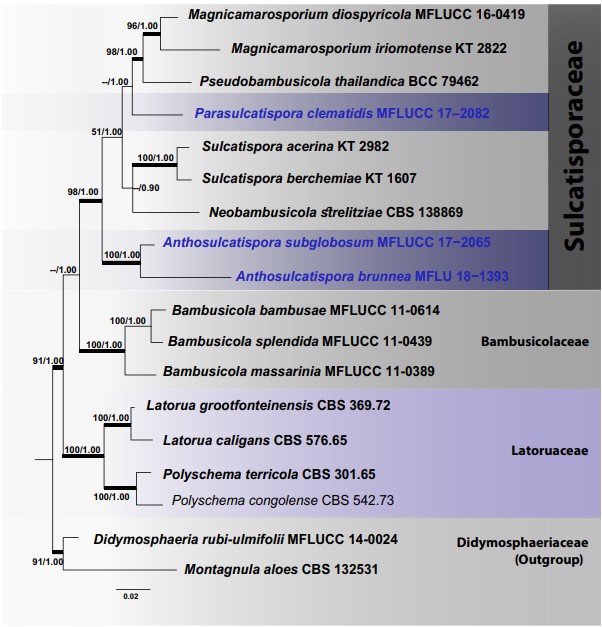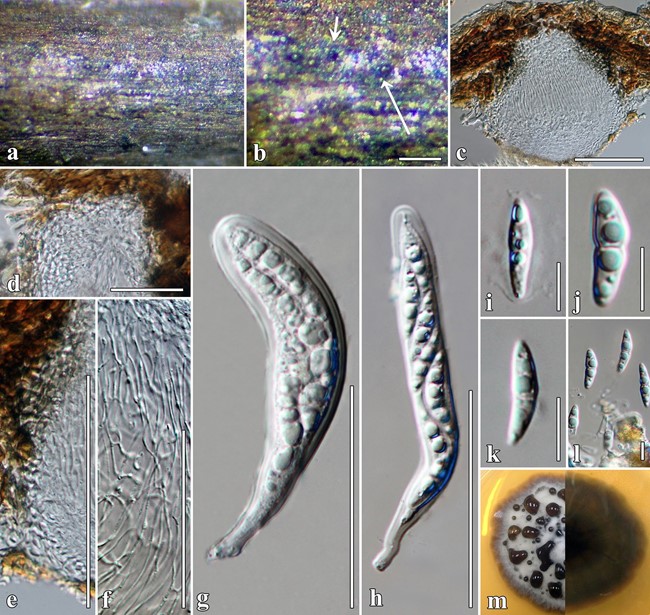Parasulcatispora clematidis Phukhams. & K.D. Hyde, sp. nov.
MycoBank number: MB 557205; Index Fungorum number: IF 557205; Facesoffungi number: FoF 07342; Fig. 74.
Etymology: The specific name “clematidis” refers to the host substrate.
Holotype: MFLU 17–1490.
Saprobic on dead stems of Clematis fulvicoma. Sexual morph: Ascomata 160–230 × 230–320 μm ( x̄ = 190 × 305 μm, n = 5), solitary, gregarious, semi-immersed to erumpent, subglobose to compressed, coriaceous, dark brown to black, only ostiole visible, ostiolate. Ostioles 84–115 × 116–133 μm ( x̄ = 100 × 124 μm, n = 5), shiny, central, smooth-walled, filled with hyaline periphyses. Peridium 22–37 μm wide (x̄ = 19 μm, n= 20), uniform, wider at the apex, composed of 3–4 layers of somewhat flattened cells of textura angularis, thin-walled, cells towards the inside lighter, inner layer composed of thin hyaline gelati- nous layer. Hamathecium composed of numerous, dense, 2–3 µm wide, filamentous, branched, septate, anastomosing, trabecular pseudoparaphyses, embedded in a gelati- nous matrix. Asci 53–88 × 8–17 µm (x̄ = 72 × 13 µm, n = 30), 8-spored, bitunicate, fissitunicate, cylindrical-clavate to clavate, asymmetric, with furcate pedicel, apically rounded, with an ocular chamber. Ascospores 16–21 × 4–6 µm ( x̄ = 17 × 5 µm, n = 40), biseriate or partially overlapping, broad fusiform with acute ends, tapering towards the ends, 1-euseptate, constricted at the septum, upper cell broader than lower cell, smooth-walled, with two guttules in each cell, hyaline, with 4–7 µm wide mucilaginous appendages. Asexual morph: Undetermined.
Culture characters: Colonies on MEA reaching 30 mm diam. after 4 weeks at 25 °C. Culture from above, greyish brown, covered with grey fluffy mycelia, dense, circular, umbonate, dull, undulate, radially furrowed, yellow oil droplets formed in the middle of cultures; reverse grey, radiating outwardly.
Material examined: Thailand, Chiang Rai Province, Mae Sai District, dried stems of Clematis fulvicoma, 20 March 2017, C. Phukhamsakda, CMTH28 (MFLU 17–1490, holo- type); ex-type living culture, MFLUCC 17–2082.
Host: Clematis fulvicoma—(This study).
Distribution: Thailand—(This study).
GenBank accession numbers: LSU: MT214593; ITS: MT310637; tef1: MT394650.
Notes: Parasulcatispora clematidis can be distinguished morphologically (Fig. 74) and is supported by the phylogenetic analyses of combined LSU, SSU, ITS and tef1 data (Tanaka et al. 2015, Fig. 72). The isolate MFLUCC 17–2082 also produces oil droplets in culture, and was further evaluated for the possibility of bioactive secondary metabolite production. The isolate MFLUCC 17–2082 inhibited the growth of Bacillus subtillis and partially inhibited conidial production of Mucor plumbeus, but did not reach significant values (data not shown).

Fig. 72 Bayesian 50% majority-rule consensus phylogram based on combined LSU, ITS, SSU and tef1 sequence data for Sulcatisporaceae. The topology and clade stability of the combined gene analyses was compared to the single gene analyses. The tree is rooted with members of the Didymosphaeriaceae. Eighteen strains were included in the combined analyses which comprised 3390 characters (843 characters for LSU, 1025 characters for SSU, 585 characters for ITS, 937 characters for tef1, including gap regions). The best scoring RAxML tree had a final likelihood value of − 11220.180237. The matrix had 709 distinct alignment patterns, with 31.84% of undetermined characters and gaps. Estimated base frequencies were as follows; A = 0.238159, C = 0.264197, G = 0.261408, T = 0.236236; substitution rates AC = 0.958607, AG = 2.023708, AT = 1.033715, CG = 0.741292, CT = 5.717037, GT = 1.000000; gamma distribution shape parameter α = 0.485427. In our analysis, GTR + I + G model was used for each partition in Bayesian posterior analysis. The species determined in this study are indicated in blue. Bootstrap values (BS) greater than 50% BS (ML, left) and Bayesian posterior probabilities (BYPP, right) greater than 0.90 are given at the nodes. Hyphens (-) represent support values less than 50% BS/0.90 BYPP. Thick branches represent significant support values from all analyses (BS ≥ 70%/BYPP ≥ 0.95)

Fig. 74 Parasulcatispora clematidis (MFLU 17–1490, holotype). a Appearance of ascomata on host surface. b Close up of ascoma on host substrate. c Vertical section through ascoma. d Ostiolar canal. e Section of peridium. f Trabeculate pseudoparaphyses. g–h Asci. i–l Ascospores. m Culture characteristics on MEA. Scale bars: b = 200 µm, c = 100 µm, d = 20 µm, e–h = 50 µm, i–l = 10 µm
